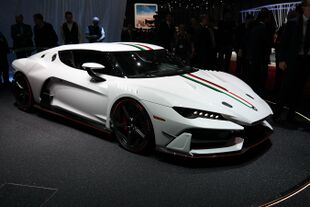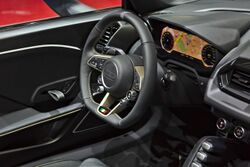Engineering:Italdesign Zerouno
| Italdesign ZeroUno | |
|---|---|
 ZeroUno coupe | |
| Overview | |
| Manufacturer | Italdesign Giugiaro |
| Production | 2017–present |
| Designer | Filippo Perini |
| Body and chassis | |
| Class | Sports car (S) |
| Body style | 2-door coupe (ZeroUno) 2-door roadster (ZeroUno Duerta) |
| Layout | Mid-engine, four-wheel-drive |
| Platform | Volkswagen Group Modular Sports System Platform |
| Related | Lamborghini Huracán Audi R8 (Type 4S) |
| Powertrain | |
| Engine | 5.2 L FSI V10 (Lamborghini V10) |
| Transmission | 7-speed dual clutch |
| Dimensions | |
| Wheelbase | 2,650 mm (104.3 in) |
| Length | 4,847 mm (190.8 in) |
| Width | 1,970 mm (77.6 in) |
| Height | 1,240 mm (48.8 in) |
The Italdesign Zerouno is a sports car produced by Italian Automotive styling house Italdesign Giugiaro and was introduced in 2017. The Zerouno is the first car sold under the name of the Moncalieri design house and was created by their Italdesign Automobili Speciali division.[1] The name means "Zero One", as it is the first production vehicle from Italdesign's low production sports car division, Italdesign Automobili Speciali.[2]
Production
The Zerouno coupé was introduced in 2017 at the Geneva Motor Show and had a limited production run of 5 units, all of which, according to the company, have been sold. The coupé had a base price of US$1.7 million. The Zerouno Duerta (roadster) was introduced at the 2018 Geneva Motor Show and is also limited to 5 cars.[3]
Specifications and performance
The car is powered by the mid-mounted 5.2 litre naturally aspirated V10 engine (used in the Audi R8 and Lamborghini Huracán) and produces 602 hp (449 kW; 610 PS) at 8,250 rpm and 520 Nm (383.5 lb ft) of torque at 6,500 rpm, with power going to all four wheels through a seven-speed dual-clutch transmission. The Zerouno uses a modular carbon fibre and aluminium chassis and has body work made of carbon fibre.[4] It has a top speed of 205 mph (330 km/h) and can accelerate from a standstill to 60 miles per hour in 3.2 seconds.[5]
References
 |
- ↑ "Italdesign Zerouno Roadster headed for Geneva Motor Show" (in en). Autoblog. https://www.autoblog.com/2018/02/21/italdesign-zerouno-roadster-geneva-motor-show/#slide-endcap.
- ↑ "Italdesign Zerouno is the first model from new bespoke sub-brand" (in en). Evo. http://www.evo.co.uk/news/18860/italdesign-zerouno-is-the-first-model-from-new-bespoke-sub-brand.
- ↑ "Italdesign Zerouno Duerta debuts in Geneva, limited to 5 cars" (in en). Motor Authority. https://www.motorauthority.com/news/1115307_italdesign-zerouno-duerta-debuts-in-geneva-limited-to-5-cars.
- ↑ "The Italdesign ZeroUno Roadster: For When a Pagani Is Just Too Commonplace" (in en-US). Road & Track. 2018-02-23. https://www.roadandtrack.com/new-cars/future-cars/a18672606/italdesign-zerouno-specs-pictures-pricing/.
- ↑ Constantine, Chris. "$1.7 Million Italdesign Zerouno Supercar Sold Out Before Its Debut" (in en-US). The Drive. http://www.thedrive.com/sheetmetal/13289/1-7-million-italdesign-zerouno-supercar-sold-out-before-its-debut.




